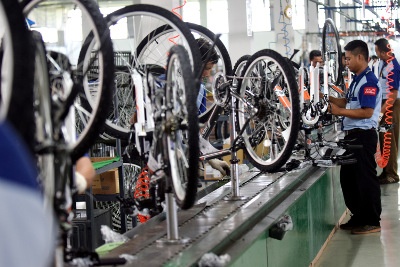Each Sunday, we publish a list of top articles and other content related to manufacturing in areas like quality control, product development, supply chain management, sourcing, auditing and law.
1. Advice for selecting an appropriate manufacturing partner
 The author of this featured article makes a pretty apt comparison between a buyer and supplier – it’s like a marriage. There’s a courting phase, engagement phase and finally that moment at the altar, a.k.a. sealing the deal for your first order. But if the supplier doesn’t fit with your product, goals and standards, then you can forget about a long lasting relationship. It’s also a disaster if the supplier doesn’t feel the same way about managing product quality as you do.
The author of this featured article makes a pretty apt comparison between a buyer and supplier – it’s like a marriage. There’s a courting phase, engagement phase and finally that moment at the altar, a.k.a. sealing the deal for your first order. But if the supplier doesn’t fit with your product, goals and standards, then you can forget about a long lasting relationship. It’s also a disaster if the supplier doesn’t feel the same way about managing product quality as you do.
Unfortunately, the author doesn’t provide any groundbreaking dating and marriage advice. He does, however, provide a trove of insight regarding how to find the supplier that’s right for your needs. He mentions a few questions for selecting a supplier:
- Does the supplier’s production capabilities meet your requirements?
- Do you need to order a minimum number of units?
- Can the supplier provide design support?
While these are only a few of the questions mentioned by the author, he goes on to list the various types of options of suppliers, such as:
- Service bureaus: work with you at every stage of the manufacturing process and usually have a wide range of services
- Service brokers: might be a better fit for smaller companies and offer services for particular industries
- Independent machine shops: typically excel at specific services and in dealing with certain materials/processes
- High-volume production houses: offer cost and time savings through bulk orders
- In-house production: greater control over manufacturing processes, but you may lack the resources of other providers
In addition to what’s above, what do you think are the essential considerations for selecting a supplier? Let us know in the comments section below!
To read about the other questions for selecting suppliers and the pros and cons of different types of suppliers, check out the full article in the link below:
How to Select a Manufacturing Supplier – Jeff Schipper, Engineering.com
2. Manufacturing potential in the Philippines
As minimum wages continue to increase in popular manufacturing destinations like China, that means some importers and manufacturers will start looking at new locales for production. Depending on what they need, one potential country to meet their needs might be the Philippines.
A few metrics support the idea of moving to the Philippines for manufacturing:
- 2016 saw economic growth of 6.8 percent
- Manufacturing accounts for a quarter of GDP
- The manufacturing sector grew more than 6 percent in 2016
- Nearly half of all approved foreign direct investment goes towards manufacturing
In addition to the above data, English is widely-spoken in the Philippines. English fluency makes training employees much easier than in other Asian nations, like China and Vietnam. With this benefit, foreign managers also able to speak English can more easily arrive in the Philippines, set up shop, commence training and get production going.
Additionally, as the featured article notes, the population of the Philippines is much more educated than that of other AESEAN nations. Approximately 21 percent of the labor force is educated to a tertiary level, which even surpasses Singapore at 16 percent.
Taken together, all these benefits make the Philippines a competitive option for manufacturing. Get the full scoop on manufacturing in the Philippines by checking out the article in the link below:
The Philippines: The Prospect for Manufacturing Relocation – Kenix Lee, HKTDC Research
3. A joint Hong Kong & Shenzhen tech park
Hong Kong (HK) and Shenzhen (SZ) are two very impressive cities in Southern China. In 2016, the GDP of HK and SZ were $321 billion and $281 billion, respectively. The financial and legal expertise of HK in such close proximity to SZ’s remarkable manufacturing capabilities creates an area full of potential. And now, the governments of both cities are cooperating for more interconnectedness in a bid to breed successful new companies.
 The Lok Ma Chau Loop on the border between HK and SZ is a giant, 87-hectare proposed technology park. The area would benefit from the freedoms and legal framework of HK but remain just a stone’s throw away from serious production capabilities in SZ.
The Lok Ma Chau Loop on the border between HK and SZ is a giant, 87-hectare proposed technology park. The area would benefit from the freedoms and legal framework of HK but remain just a stone’s throw away from serious production capabilities in SZ.
The chairman of Tencent, Pony Ma Huateng, had this to say about a Chinese tech park,
[China] has the ability to create a world-class tech Bay Area, and preside over the global tech revolution of the future.
Even though part of the effort to produce a world-leading tech park stems from HK’s desire to stay competitive with other cities like SZ itself, Shanghai and Singapore, it could potentially become a new innovation hub. Importers and startups might be able to research and create physical products much faster at the Lok Ma Chau Loop than in other places, like Silicon Valley, due to all the right resources being so close together.
Curious about the proposed tech park between HK and SZ? Learn more about it by reading the article in the link below:
Hong Kong Cozies Up to Shenzhen to Create Future Tech Giants – Natasha Khan and Enda Curran, Bloomberg
4. Printable electronics: an upgrade to manufacturing
How would you like to monitor your heart rate with a normal looking t-shirt? Or make batteries, LEDs, displays, conductors and more with technology that isn’t cumbersome? Although these product categories may sound unrelated, they’re united by their potential to be revolutionized by printable electronics (PE).
PEs are made with inks that are capable of conducting electricity (Related: Conductive Inks: the Next Big Step in Printed Electronics). Materials like copper, silver and graphite are a few options for materials in PEs. The materials can form a complete electronic circuit but can be applied to flexible and stretchable materials, among others.
And there are more benefits. Components made of PEs are cheaper to make, thinner and lighter. Plus, using PE technology in manufacturing eliminates the need for certain processes involved in handling silicon that can harm the environment.
In the words of the author of this featured article,
With PE, electronics can be embedded into printed 3D devices and components. We can enable a new generation of wearable healthcare technologies, smart fabrics, flexible electronics, connected homes that conserve energy, and even smart packaging that can reduce food and packaging waste.
These possibilities aren’t just empty talk. With a projected market value of $70 billion by 2024, there are clearly enough businesses that believe PE technology shows promise.
Importers and manufacturers that integrate this developing technology into their product lines might be able to tap into the burgeoning market for it. Although it sounds like something out of the far future, printed electronics are quickly becoming a reality, and those that start working with them sooner rather than later will get a bigger part of the PE profit pie.
To learn more about printable electronics, check out the full article in the link below:
Printable Electronics: Novel Technique Offers a World of Opportunity – Peter Kallai, R&D Mag
5. Interview: the reality of manufacturing some products in the U.S.A.
The age-old phrase “you get what you pay for” frequently holds true in manufacturing. But as a consumer, w ould you be willing to pay more for something that’s made in the United States?
ould you be willing to pay more for something that’s made in the United States?
The man interviewed in this featured article, Zak Pashak, believes just that. His high-quality bikes sell for $600, while similar bikes go for $500. Despite this price gap, each consumer is different. Some might be willing to pay an extra $100 for a bike, while others would rather go the cheaper route.
What’s important about this article is that it touches on the (sometimes substantial) price difference between domestically made and internationally sourced products. The article mentions:
[Interviewer]: Why are 99% of bikes made in Asia?
Pashak: It’s cheaper. For just the material cost of my bike you can buy an entire bike from overseas.
Similar to the production of bicycles, garment production is labor intensive, which is why it left places like the U.S. in favor of destinations with cheaper wages and overall manufacturing costs. Whether you’re producing bikes, clothes or any other consumer item, in a great deal of cases it just makes more economic sense to produce abroad. But is this really always the case? Let us know in the comments below!
To read the rest of this interview, check it out in the link below:
At Detroit Bikes, Idealism Meets the Reality of Manufacturing in the U.S.A. – Susan Adams, Forbes
We’re constantly scanning the web for top manufacturing stories and news. If you’d like to submit an article for consideration for our weekly Best in Manufacturing, send us a message and let us know.







